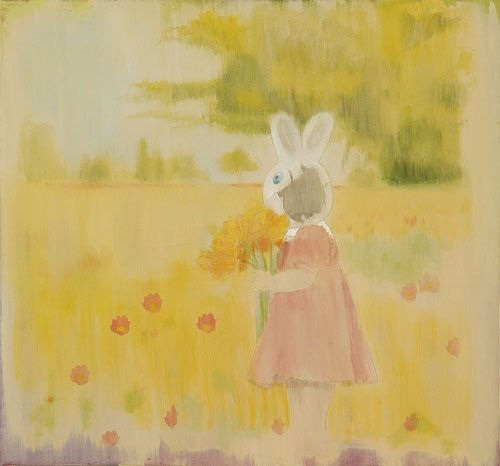Eat Me, Protect Me
X-ist Gallery
April 8 - May 2 2006
In her first show the viewer was faced with childhood as a reference point where young girls were caught between being spectators to various natural and manmade disasters and/or being the suspected protagonists of the same. The undefined line between arsonist and spectator.
In the latest show by Birecikligil we revisit maybe the same geography but from a different perspective. This is a tourist visa to a place we had forgotten, to a more innocent time where one had the security of the imagination. Away from the calcified, stagnant, industrial hyperreality of the now. A chance to revisit the heroes, and talismans of our past, and walk through the gardens of our childhood with a mature sense of consciousness.

Oil on canvas, 120 x 180 cm, 2005

Oil on canvas, 120 x 180 cm, 2005

Oil on canvas, 110 x 180 cm, 2005

Oil on canvas, 130 x 150 cm, 2005

Oil on canvas, 95 x 115 cm, 2006

Oil on canvas, 70 x 75 cm, 2006

Oil on canvas, 95 x 115 cm, 2006

Oil on canvas, 70 x 75 cm, 2005

Oil on canvas, 70 x 75 cm, 2005

Oil on canvas, 70 x 75 cm, 2006

Oil on canvas, 95 x 130 cm, 2005

Oil on canvas, 70 x 75 cm, 2006

Oil on canvas, 30 x 25 cm, 2005

Oil on canvas, 30 x 25 cm, 2005
Eat me, Protect me
Fourteen frames from the lost diary of the age of migrant imagery
Evrim Altug
In the relatively “crowded” paintings we encounter in artist Banu Birecikligil's second solo exhibition, we see images of the feral speed of the human condition of migration and the remnants of that speed, which have been re-memorised, encrusted and frozen, yet remain prone to recollection.
Essentially, these are Birecikligil's F-self-portrait copies: orphaned, drifting unconsciously between photography and dream, yet irreversibly rigid on the canvas, crumbling like dead fragments cut by colours, becoming “anyone” among collage destinies and other things.
Whether to identify or not with the imaginary body he has captured in 14 frames is entirely the viewer's problem. Their responsibility.
In this sense, the text you are reading also resembles, in a way, the leaflet of an “medicine” you know nothing about, presented to you in 14 paintings.
Whether or not to swallow all the pills is up to you. They are all there, but always hidden in a strange adult awareness, out of reach of children: because this is the frightening chaos of a stray dog, of all kinds of household waste found only in the market of the past, of familiar faces forgotten. The motif with its patchwork, the signifier with its signified, the forbidden, cautionary love in the absurd, everyday form of the fairy tale. The “investigative side” of the pictures here, which becomes apparent as they are hidden, is also the moment when the mind, which deceives truth with fantasy, is caught out on the canvas, that moment of self-capture.
It is equally vexing. The transience of this commotion can be discerned from the gazes of the seven dwarfs standing side by side, who have no commonality other than being dwarfs, and from its excessive design.
In Birecikligil's paintings, which evoke Brecht's spirit with brushstrokes, the dissatisfaction of the passive landscape light, which has begun to sour, is like the fate of the many vital or intrinsically vital figures exposed to 'conspiracy-sion ' within the same composition.
The helpless mockery of its lostness, yet the unhappy, spoilt speed of the urban eye that cannot deceive itself. Or the loneliness of a naïve world, stacked between the surreal and the subliminal, abandoned by its painter to the world as a homeland.
The silent, sincere curiosity of a pair of eager, longing eyes asking about the new paintings that will be seen by the paintings that will never go to the places they belong.
If it were up to me, I would say stop reading.
Because the rabbits, princesses, dinosaurs, even the dogs and whales in these paintings are actually busy watching you with relish from the very beginning.
Like cheap nylon photo albums with imaginary covers, searching for a life of their own, they are hungrier than you could ever imagine for your memory.